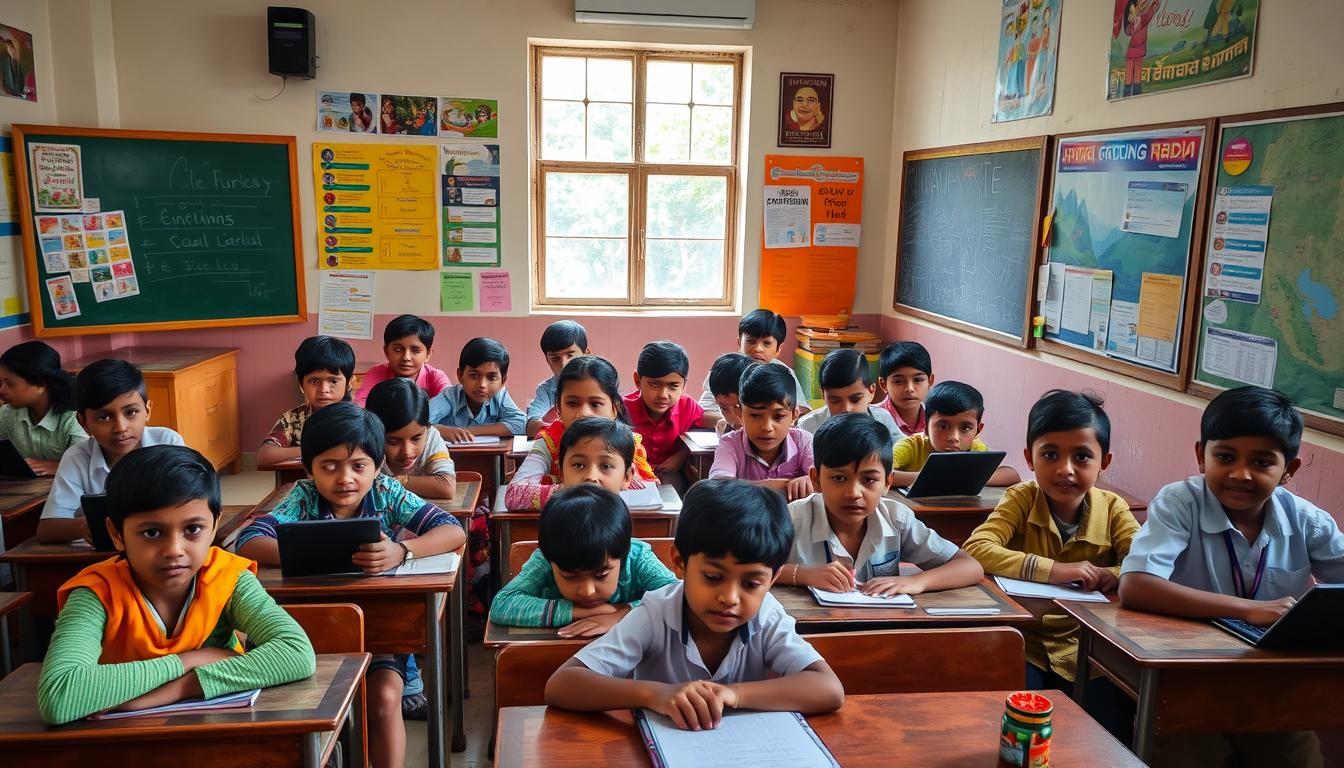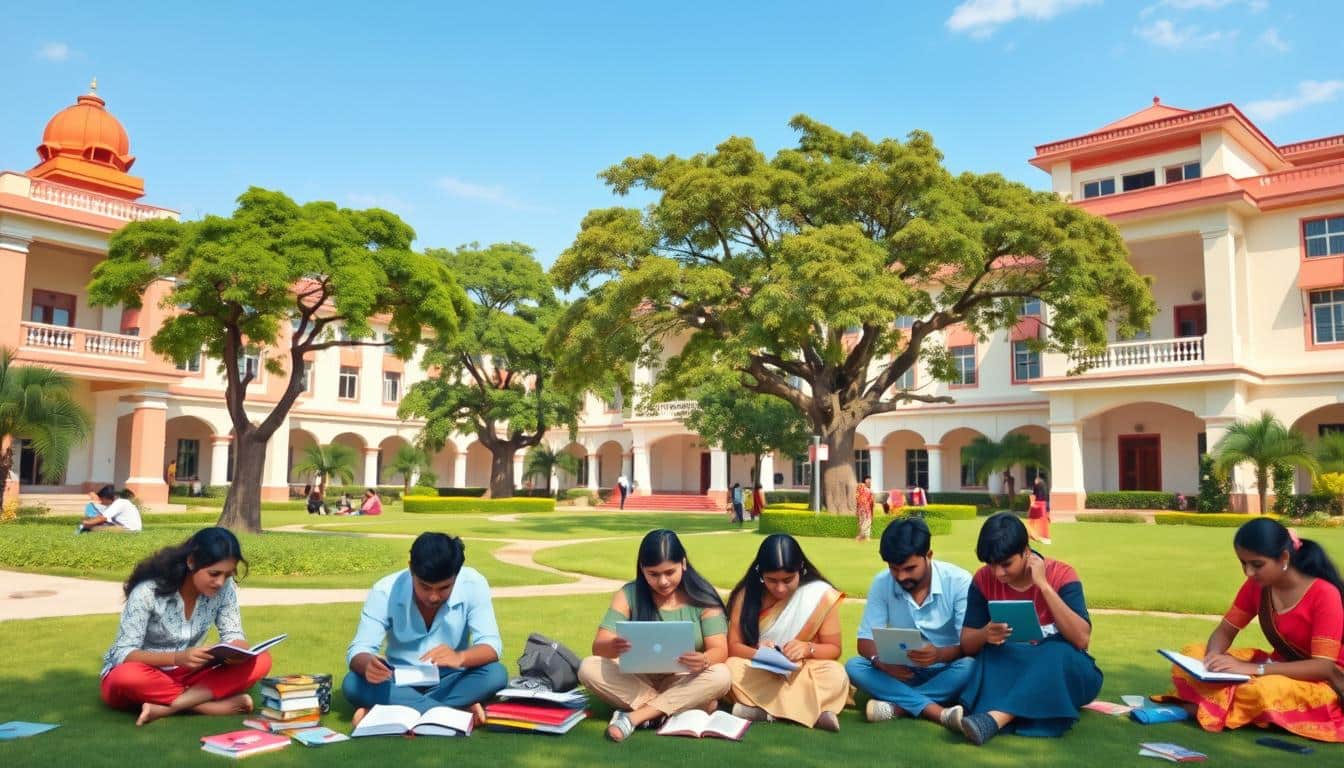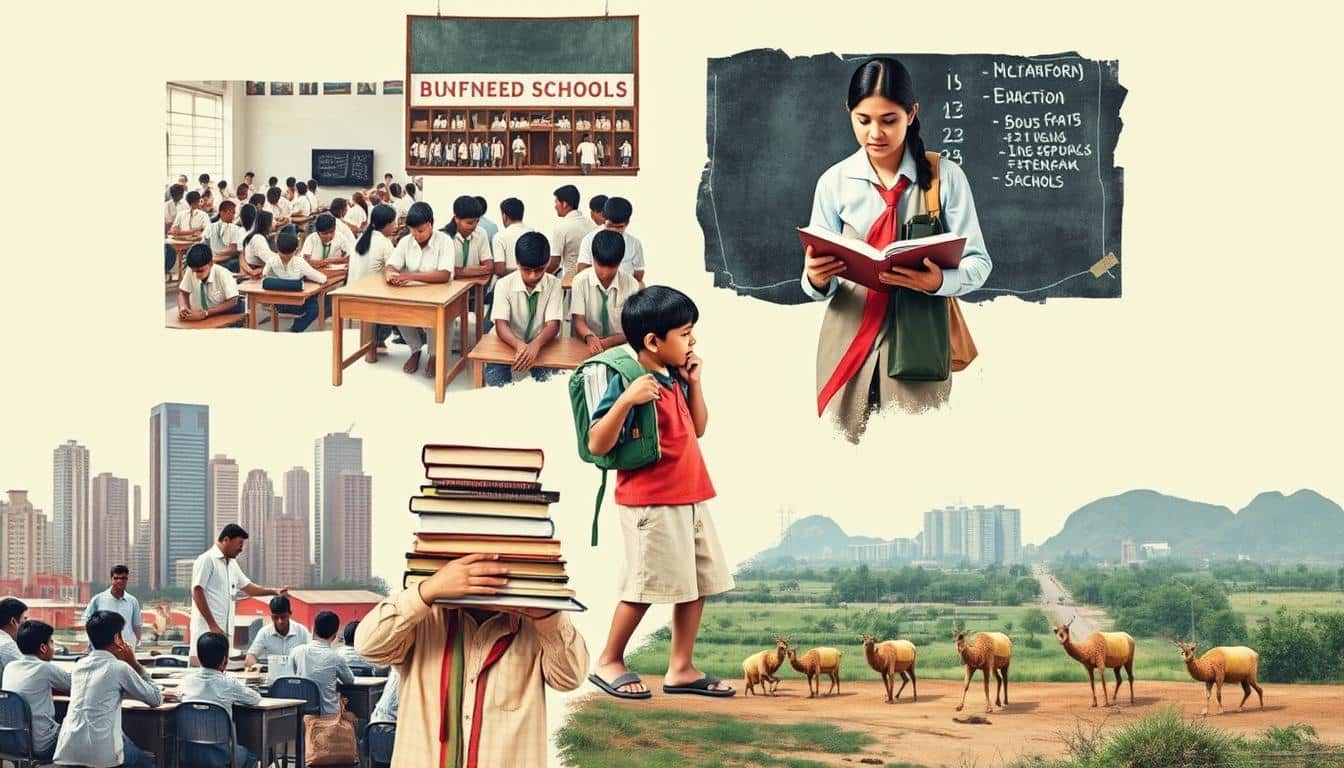The Indian Education System
“Education is the most powerful weapon which you can use to change the world.” – Nelson Mandela
India’s education system has a long and complex history. It has been shaped by many factors, including ancient traditions and modern changes. This overview will explore the system’s roots, structure, policies, and the challenges it faces today.

Key Topics
- India’s education system has a rich historical legacy, encompassing ancient Vedic Gurukulas and colonial influences.
- The current structure of the Indian education system includes primary, secondary, and higher education frameworks.
- Landmark policies like the National Education Policy 2020 and the Right to Education Act have significantly shaped modern education in India.
- Technological advancements and digital transformation are revolutionizing the Indian education landscape.
- Challenges such as access, quality, and equity continue to shape the evolving Indian education system.
Evolution of Education in India: From Ancient Gurukulas to Modern Classrooms
The education system in India has a long and rich history. It goes back to the ancient Vedic era. The Gurukula system, where students lived with their teachers, started India’s love for learning.
The Vedic Education Legacy
In the Vedic period, before the Common Era, education flourished. Students, called shishyas, lived in Gurukulas. They learned the Vedas, Sanskrit, philosophy, math, and sciences.
This approach aimed to grow students’ minds and spirits. It focused on both knowledge and moral character.
Colonial Influence on Indian Education
When colonial powers came to India, education changed a lot. The British brought a Western education model. It focused on English and subjects useful for the colonial rule.
This change slowly took away the old Gurukula ways. These had been around for thousands of years.
Post-Independence Transformation
After India became free in 1947, it worked to bring back its educational roots. Leaders wanted to keep the Vedic legacy alive while adding new ideas to education.
This time saw big educational reforms in india. These reforms helped make education more fair and open to everyone.
“Education is the most powerful weapon which you can use to change the world.” – Nelson Mandela
Structure of the Indian Education System
India’s education system is complex and has many levels. It starts with primary education and goes up to higher education. Primary education is the first step for a child’s learning journey. Higher education is for those who want to get advanced degrees and learn more about their field.
The Indian education system has several stages:
- Pre-primary Education: This includes nursery, kindergarten, and preschool. It gets kids ready for school.
- Primary Education: This stage is from grades 1 to 5 or 1 to 8, depending on where you are. It focuses on basic subjects like math, language, and science.
- Secondary Education: Secondary education is split into two parts: lower secondary (grades 9-10) and upper secondary (grades 11-12). It prepares students for college or vocational training.
- Higher Education: Higher education includes universities, colleges, and technical schools. Students can get undergraduate, postgraduate, and doctoral degrees here.
The system is overseen by many bodies, like the Ministry of Education and the University Grants Commission (UGC). These groups help set rules, standards, and requirements for schools and colleges.
The Indian education system aims to give a complete learning experience. It helps students grow from primary education to higher degrees. The goal is to make well-rounded individuals who can help the country grow.
Primary and Secondary Education Framework
India’s primary and secondary education system is key to the nation’s future. It covers everything from elementary education to board exams. This framework is vital for primary education in India and ensuring the quality of education in India.
Elementary Education Guidelines
The Right to Education (RTE) Act guides primary education in India. It makes schooling free and compulsory for kids aged 6 to 14. The act sets rules for student-teacher ratios, school infrastructure, and includes all students, no matter their background.
Secondary School Structure
Secondary education in India has two parts: lower secondary (classes 9-10) and higher secondary (classes 11-12). This setup helps students move from basic to advanced studies. It prepares them for college or the workforce.
Board Examination Systems
- Central Board of Secondary Education (CBSE): A major national board that sets curricula and holds exams for schools nationwide.
- Council for the Indian School Certificate Examinations (CISCE): An independent board that oversees the Indian Certificate of Secondary Education (ICSE) and Indian School Certificate (ISC) exams.
- State Boards: Each state has its own board that designs and administers exams for local schools.
These different board systems give students many ways to show their skills. They help open doors to higher education.
Higher Education Landscape in India
India’s higher education system is vast and diverse. It has many universities, colleges, and specialized institutes. These places offer a wide range of academic and vocational training.
This sector is key in shaping the country’s skilled workforce and future leaders. It includes prestigious universities and innovative vocational training programs.
Universities and Colleges
India has many universities, both public and private. They offer a variety of undergraduate and postgraduate programs. These institutions are known for their academic excellence and research.
Students from all over the country and the world come here. Some top examples are the Indian Institutes of Technology (IITs), the Indian Institutes of Management (IIMs), and the Jawaharlal Nehru University (JNU).
Vocational Training and Skill Development
India also focuses on vocational training and skill development. These programs aim to give people practical, industry-relevant skills. They meet the growing demand for a skilled workforce in various sectors.
From technical and vocational schools to specialized training institutes, there are many learning opportunities. These programs cater to the diverse needs of the Indian economy.
| Indicator | Public Higher Education | Private Higher Education |
|---|---|---|
| Number of Institutions | 409 | 34,014 |
| Enrollment | 9.6 million | 15.9 million |
| Funding Sources | Government Grants | Tuition Fees |
The higher education landscape in India is changing. The government is working hard to expand access and improve quality. As the demand for skilled professionals grows, the mix of traditional universities and vocational training will be crucial.
This mix will shape the future of higher education in India and vocational training in India.

Educational Policies Shaping Modern India
India’s education system has seen big changes in recent years. These changes come from new educational policies and reforms. The National Education Policy 2020 is a key part of this change. It aims to change how India learns and develops skills.
National Education Policy 2020
The National Education Policy 2020 (NEP 2020) is a detailed plan for the Indian education system. It focuses on early childhood care and vocational education. It also promotes learning in many areas at once.
The policy wants to make quality education available to everyone. It especially wants to help those who are often left behind. It also encourages research and new ideas.
Right to Education Act
The Right to Education (RTE) Act, passed in 2009, ensures free education for kids aged 6 to 14. This law has helped more kids go to school and stay there. It has helped especially those who are less fortunate.
Digital Education Initiatives
The Indian government sees technology as a big chance to improve education. It has started digital education programs to help more people learn. These programs include the National Mission on Education through Information and Communication Technology (NMEICT) and the Pradhan Mantri e-Vidya scheme.
These programs aim to give schools the tools they need. They provide digital resources, online content, and training for teachers. This is all to make learning better and more accessible for everyone.
These policies and reforms are building a better education system in India. They are preparing the country’s youth to be active in its growth and progress.
Challenges in the Indian Education System
India’s education system is making progress but still faces many challenges. These include access, quality, infrastructure, and teacher training. These issues affect learning outcomes, especially in rural areas.
Access and Equity Concerns
Ensuring fair access to education is a big challenge. Rural areas often lack schools and resources. This creates big gaps in education between cities and rural areas.
Quality and Curriculum Gaps
Education quality is a concern. Issues include outdated curricula and limited modern learning tools. Fixing these gaps is key to preparing students for today’s jobs.
Infrastructure and Resource Constraints
There’s a lack of classrooms, labs, and tech spaces. Fixing these gaps is vital for a good learning environment.
Teacher Training and Retention
Quality teacher training and keeping good teachers is hard. Improving teacher skills and making teaching a desirable career can help.
Challenges in Rural Education
Rural education in India faces big challenges. There’s limited access to schools and poor infrastructure. Community efforts are needed to improve rural education.
| Challenge | Description |
|---|---|
| Access and Equity | Disparities in educational opportunities between urban and rural areas |
| Quality and Curriculum | Outdated curricula, inadequate teaching methods, and limited access to modern learning tools |
| Infrastructure and Resources | Shortage of classrooms, laboratories, and technology-enabled learning spaces |
| Teacher Training and Retention | Ensuring high-quality teacher training and retaining skilled educators |
| Rural Education Challenges | Limited access to schools, subpar infrastructure, and socioeconomic barriers |
Fixing these challenges in Indian education needs a team effort. Policymakers, educators, and communities must work together. By focusing on access, quality, and resources, India can reach its full educational potential.

Role of Technology and Digital Transformation
The Indian education system is changing fast, thanks to technology. Educational technology (EdTech) is making learning better, more fun, and easier for students everywhere.
EdTech Revolution
EdTech in India is growing fast. New tools and platforms are helping students learn in new ways. AI and online courses are changing how we learn.
Online Learning Platforms
Online learning is changing education in India. Students can learn at home, whenever they want. Sites like Byju’s, Unacademy, and Vedantu offer lots of digital content and personalized learning.
Digital Infrastructure Development
The Indian government is working hard to improve digital education. They’re building a strong digital system. This includes the National Digital Education Architecture (NDEAR) and the National Education Technology Forum (NETF).
Using technology in education has its challenges. But the benefits are huge. With edtech in Indian education, the country can improve the quality of education in India. This way, every student can get great learning opportunities.
Public vs Private Education in India
The Indian education system has both public and private schools. Each plays a big role in shaping the quality of education in India. It’s important to understand the differences between these two paths to assess the indian education system.
Public schools, also known as government schools, are funded by the state or central government. They offer education at a lower cost, making it accessible to students from different backgrounds. These schools aim to provide a basic, standardized curriculum to ensure all children get a foundational education.
Private schools, on the other hand, are run and funded by private entities. They often focus on academic excellence, extracurricular activities, and modern teaching methods. But, the cost of attending a private school can be a big challenge for many families.
| Public Schools | Private Schools |
|---|---|
| Lower cost of education | Higher cost of education |
| Standardized curriculum | Diverse and personalized curriculum |
| Limited resources and infrastructure | Extensive resources and modern facilities |
| Greater accessibility for underprivileged students | Cater to a diverse socioeconomic spectrum |
The debate on privatizing education in India is ongoing. Some say it promotes competitiveness and innovation. Others argue it widens educational inequalities. A balanced approach that uses the strengths of both public and private schools might improve the quality of education in India.
Conclusion
The Indian education system has changed a lot. It started with ancient Vedic roots and now it’s a modern, diverse system. This change came from colonial times, after independence, and ongoing efforts to solve education’s challenges.
Looking at the Indian education system today, we see big steps forward. There’s more access, better quality, and more technology. Policies like the National Education Policy 2020 and the Right to Education Act have helped make learning fairer for everyone.
To keep improving, India needs to keep working on education reforms. It’s important to invest in digital tools, train teachers, and build strong partnerships between public and private sectors. By focusing on skills, adaptability, and holistic development, India’s education can help its youth reach their full potential. This will boost the country’s economy and society.
FAQ
What is the structure of the Indian education system?
The Indian education system has many stages. It starts with primary education, then moves to secondary and higher education. It is overseen by bodies like the Central Board of Secondary Education (CBSE) and state boards.
What are the key educational policies that have shaped modern India?
Important policies include the National Education Policy 2020 and the Right to Education Act. Digital education initiatives have also played a big role in improving education.
What are the main challenges faced by the Indian education system?
The system struggles with access, quality, and infrastructure. Teacher training is also a big issue. Rural areas face unique challenges in getting quality education.
How is technology transforming education in India?
Technology has changed Indian education a lot. Online learning platforms and digital tools have improved education quality. This is thanks to the EdTech revolution.
What are the differences between public and private education in India?
Public schools are cheaper and more accessible. But, private schools often provide better education. The debate on privatizing education is ongoing.















